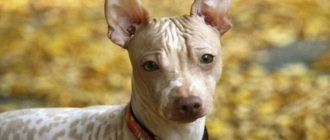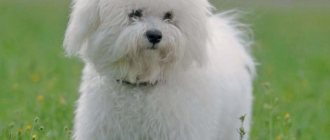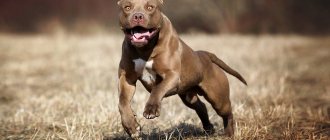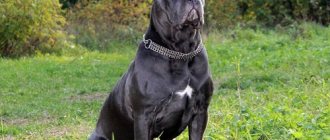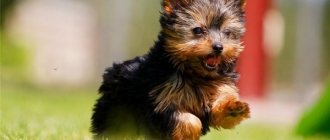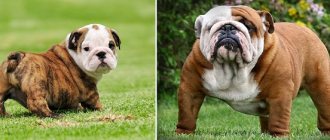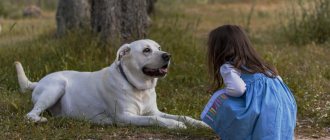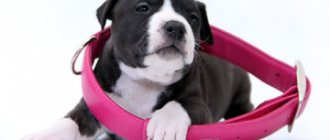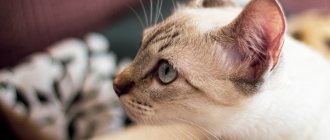Miniature short-haired dogs are ideal for keeping in small apartments. However, not only this fact makes them popular among lovers of decorative breeds. From the moment the baby appears in the house, it becomes an object of adoration for all family members, from the elderly to the little ones.
The advantages of short-haired dogs of small sizes are the almost complete absence of shedding (in most breeds), savings in the cost of salon procedures, neatness, friendly character, affection for the owner and, of course, an attractive exterior.
Boston Terrier
The Boston Terrier is a charming dog with a sharp mind, refined manners and attractive appearance. The weight of these robust creatures varies from 6.8 to 11.3 kilograms.
The character of Boston Terriers is emotional, cheerful, sociable, although a little stubborn, requiring attention to their person. From their fighting ancestors they inherited a pugnacious and quarrelsome disposition. However, as a rule, there are no difficulties in training, so representatives of the breed can be adopted by inexperienced dog breeders.
Boston Terriers adore children and enjoy participating in childish activities. But it is impossible to train them to be guards; they are too trusting for that.
Dogs do not require much physical activity or long walks. In the absence of the owner, Boston will find something to do with himself, the main thing is to buy him more toys.
Large
Mastino Neapolitan
This is an ancient breed known for its excellent protective qualities. Behind the stern mask hides a loyal and loving dog, ready to do anything for his owner.
Shedding is moderate, but do not forget about the size of the dog - these dogs are real giants, so there will be a lot of hair. It is best to place your pet in a country house with adjacent territory. Living in an apartment is acceptable, but Mastino requires a lot of space.
Rottweiler
This large working dog was bred in Germany and was used for a long time on pastures. Nowadays, Rottweilers most often “work” as guard dogs or companions, they are very loyal to their owner, but they are stubborn. This is why the breed needs a firm hand.
Care instructions:
- Brush 2-3 times a week using a medium-hard, fine-toothed brush. During seasonal molting - twice a day.
- Remove dirt and dead hair using a special mitten.
- Bathe your pet 2-3 times a year. You can add a couple of drops of olive oil to your shampoo.
Boxer
The historical homeland of the breed is also Germany; the dogs are distinguished by their friendliness, intelligence, and activity. Due to their short fur, they do not tolerate cold or heat well, so they cannot be kept on a chain or in enclosures; they must live at home.
It is important to accustom your puppy to hygiene procedures from an early age, since it is almost impossible to wash or properly comb an adult Boxer who is not accustomed to this.
Doberman
The full name is Doberman Pinscher, the breed appeared at the end of the 19th century thanks to the work of the tax collector, Karl Doberman, who gave it the name.
The peculiarity of the coat does not allow it to be a reliable protection for the animal from the cold, which is why in winter such dogs are walked in overalls.
German dog
This dog is known for its impressive size. Thus, a representative of the breed, Zeus, reached 1.12 meters at the withers, which is considered a world record.
To keep your pet's coat smooth and shiny, you should feed it special food for giant dogs. A serious drawback of the breed is its short lifespan.
Dogue de Bordeaux
Also known as the French Mastiff. Considered to be the oldest French dog breed, you can often see the name “Bordeaux”, with a double C, which is an outdated version. It is distinguished by its muscular body, fearless disposition and calm character. This giant takes care of himself; barking and attacking “just because” is not in his rules.
The coat of these animals should always be red, but a variety of shades are allowed. These are the main breeds of dogs with short hair, each of them is interesting in its own way.
Pug
Short-haired, small, fat dogs with a flat nose and large eyes were once favorites of Chinese nobles and the British Queen Victoria. Today they are extremely popular all over the world. The weight of dogs does not exceed 8 kilograms.
Pugs have a friendly, affectionate and loyal character. These little dogs love to hug, sit in their owner's arms and constantly demand attention. Cunning and natural laziness create certain difficulties in training, but the dogs are so sweet that all shortcomings are forgiven.
Owners should take into account that pugs do not tolerate heat well, and in cold weather it is advisable to wear warm overalls. Dogs shed a lot, snore funny in their sleep and love to eat, so due to their tendency to become obese, their weight needs to be controlled.
Small Italian Greyhound (Italian Greyhound)
The origins of the Italian Greyhound are deep and ancient: the greatest distribution of this breed was observed during the Renaissance. It appears to have been a favorite breed of noble families.
The dog is known for its physical abilities in running and agility. Its height ranges from 32 to 38 cm, and its weight rarely exceeds 5 kg.
In terms of physical structure, the Italian Greyhound is practically no different from the Greyhound, differing only in its small size.
This dog is predisposed to apartment life, but still loves to play and run. Shows a lively, affectionate and flexible character, an excellent companion in the house.
French Bulldog
The French bulldog is a cute miniature copy of its larger counterparts (weight up to 14 kilograms). Dogs are distinguished by their intelligence, calm and kind disposition, which makes them attractive to single people and families with children. True, they are not always ready to endure mischief without complaint, but they will never harm children.
Despite a certain amount of selfishness and natural activity, French bulldogs are sensitive to the mood of the owner and do not impose their company. Excellent defenders, vigilantly guarding the owner's property, they intuitively sense when the owner is in danger.
They love to travel, but they don’t get along well with other pets; they especially dislike cats.
French Bulldogs love to eat and are very picky eaters. They will be happy to accompany their owner on a walk, but staying in the heat for a long time is harmful to the dog.
Basenji
Its origins should be sought in the history of the Congo. It is a small to medium sized dog that varies depending on gender. Adult males are 41 to 43 cm tall and weigh 10 to 12 kg. Adult females, on the contrary, are smaller in size: height from 38 to 41 cm and weight from 9 to 11 kg.
Characteristically, the Basenji is known for its affection, remarkable energy and predisposition to play and exercise. Also, the Basenji cannot bark; instead of barking, it makes rumbling and rumbling quiet sounds.
Shorthaired Chihuahua
Chihuahuas are one of the smallest breeds, their weight does not exceed 2.5 kilograms. The dog is so tiny that it can easily fit in your palm or pocket!
Looking at these charming dogs with big round eyes, who often become the heroes of photo shoots, it is impossible not to be touched, they are so touching and funny.
But the character of representatives of the Chihuahua breed is not simple. They are jealous, do not get along well with other pets, especially dogs, are stubborn, and using their natural charm and ingenuity, they cleverly manipulate people. In addition, they bark loudly and loudly greet strangers who appear in the house. They are not easy to train; to do this, the dog must be interested in learning.
Positive qualities include neatness, social adaptability, insight and the ability to sense the owner’s mood. So, a dog will never communicate with an aggressive person and will wait until he calms down. A pampered beauty with her own quirks - this is how you can characterize a Chihuahua.
Which one is better to get?
Before adopting a pet into your family, you need to pay attention to:
- Age of the animal . The older the individual, the more firmly formed the character and habits. If you take home an adult service dog, it will be disobedient and may not get along well with children. At an early age, you can teach your four-legged friend to obey and protect family members.
- Social behavior . If a dog likes to communicate with its fellow tribesmen, you will have to walk it in places where there are dogs of the same breed. Otherwise, the pet will feel lonely and its mood will be depressed every day. For this reason, in shelters, some rare breeds live in the same cage or in neighboring ones and cannot find their owners for a long time.
- Activity level .
There are calm and playful breeds. The first can lie on the bed all day, while others are unable to sit still for several minutes. If you are a busy person who works late, be prepared to clean up the mess left by your dog when you get home. So before you decide what kind of dog to get in a small apartment, think about whether there will be enough space and space for activity. - Contact with children . If a dog perceives an adult as the leader of the pack, then small children - as their brothers or rivals. There are dog breeds that, due to their ancestral history, are accustomed to fighting for first place in the hierarchical scheme (pit bulls, Staffordshire terriers, hounds).
- Training . There is a myth that command training is a property only of purebred dogs, but this is far from the case. With proper persistence, any individual can be taught various tricks, the main thing in this matter is perseverance. This applies to both pet and owner.
IMPORTANT! Dogs growing up surrounded by people perceive them as a pack. The owner is the leader, all the others are members of the pack.
In order not to cause disruption of reflexes and social behavior, one person should train, give commands, scold and praise. If there are many owners, it is quite possible that the dog will not recognize any of them.
It is also worth remembering that a dog also has character and a sense of pride, it will treat you the way you treat it , so don’t be surprised if even friendly breeds respond to your rude word or gesture with aggression.
Chinese Crested Dog
The Chinese Crested Hairless is a dog with an extraordinary exterior, its appearance always causing surprise and admiration of others. Despite their fragile, pampered appearance and miniature size (5 kg on average), these dogs are real lions, fearlessly defending their owner.
Because of their elegant appearance and pinkish color, Chinese crested orchids are often called Peruvian orchids. They are distinguished by their curiosity, friendliness, balanced temperament, and lack of aggression. They adore children, get along well with other pets, and are extremely distrustful of strangers.
Dogs are very emotional, they have a hard time dealing with rudeness and indifference; this fact must be taken into account when deciding to get an exotic breed. Peruvians are smart, quick-witted and easy to train. For example, if desired, they can even be taught to dance!
Due to the lack of fur, Chinese Cresteds cannot tolerate heat, and their skin needs to be regularly lubricated with moisturizer.
Small
Convenient for keeping in a city apartment; if the owner wishes, small dogs can be trained to a tray. But you will still have to walk, since most breeds need physical activity.
Pug
It looks quite cute thanks to its good-natured flattened face. In ancient times, Chinese emperors got themselves such dogs; in addition, pugs were Queen Victoria’s favorites. These animals do not tolerate low temperatures well and need careful diet planning, as they are prone to obesity.
You should comb your pet at least once a week using a hard comb, and during the molting period - every day. Wash rarely (only if necessary), using special shampoos.
Smooth Fox Terrier
The height at the withers of these animals is no more than 41 cm, weight is 7-8 kg. Despite such modest data, Foxes are excellent hunters, primarily foxes. The coat is thick, 2-3 cm long, with an undercoat that allows the pet to withstand frost.
Needs periodic brushing, and regular brushing during the shedding period. To make your dog look neat, you can visit a grooming salon with him, where a specialist will remove hair from the neck, tail, ears and hips.
Important! Dense fur takes a long time to dry after water treatments, so it is recommended to wash your pet only in the warm season.
Chihuahua
This breed is quite familiar thanks to the film “Legally Blonde”, where the baby chi was the favorite of the main character. Many people mistakenly believe that the owner of a short, thick coat does not need to be combed, but in fact, this procedure allows you to get rid of dead hairs and dirt, and is also a kind of massage. To work, you need to stock up on a natural bristle brush and cloth. The first is used 3 times a week, the second - daily.
It is recommended to bathe a Chihuahua no more than 2-3 times a year; more frequent water procedures will lead to the fact that the natural fatty layer of the skin is washed away, depriving it of protection. Use cotton towels for drying; a hair dryer is highly undesirable: hot air can burn you.
Beagle
These cheerful dogs are used to hunt hares and other small game. In addition, in the USA, representatives of the breed are engaged in “inspecting” luggage at airports, and in Australia – to detect termites. They are very dynamic, so when living in an apartment they need long active walks. They shed, especially in spring and autumn, so they need careful combing (10-15 minutes daily).
Wools of different colors can sometimes be difficult to spot and remove from furniture and carpets.
Jack Russell Terrier
This is an energetic pet, a real television star, a real record holder for high jumps. It has a hard coat that fits tightly to the body. Ideal for those who do not have enough time for regular visits to grooming salons. But do not forget that Russells, like all other dogs, shed in the spring and autumn; during these periods the pet will need to be combed.
Important! Light-colored animals can get sunburned, so it is recommended to lubricate their fur with special protective creams.
Russian toy
This is an ideal companion dog; due to its miniature size, the pet will be allowed to stay in almost any hotel without any problems. Despite the fact that toys belong to the decorative group, they can also be used in hunting burrowing animals. These are smart and brave animals that are highly trainable, but need protection from the cold.
Dachshund
A hunting breed, distinguished by its loyalty and good-natured disposition, it often becomes a companion. The short-haired variety was created by crossing miniature, rabbit and standard dachshunds. Coat care involves combing; washing can be done no more than 2-3 times a year.
Miniature Pinscher
Resembling a mini Doberman, these short-haired dogs are capable of obedience only if they completely trust their owner. The average weight of such a dog is 4-6 kg, height is up to 30 cm. The activity of dogs does not allow them to be used exclusively as decorative dogs; pinschers require regular physical activity.
The coat is smooth, very short, and has no undercoat. Your pet should be brushed every 3-4 days, and during shedding - every day.
Russian toy
Russian Toys are descended from English Toy Terriers. These are adorable miniature creatures (no more than 3 kg), unusually loyal and affectionate. The breed was bred to fight rodents, but even today the dogs have not lost their excellent hunting instincts.
Russian Toys are not characterized by aggression. Despite their toy size and cute appearance, they are excellent watchdogs and vigilantly guard the house, greeting strangers with loud barking. A huge dog will envy the fearlessness in a pet’s small heart.
The Russian Toy is friendly with all family members, loves to play with children, and is sincerely upset when he is left alone for a long time.
The lack of undercoat makes the dog vulnerable to climatic conditions. Heat is contraindicated for them, and in the cold season they should be taken outside, having previously been insulated with overalls or blankets.
Average
Shar Pei
This is a worthy representative of medium-sized smooth-haired dog breeds, distinguished by a very original appearance. His whole body is covered with folds.
There are two types of wool:
- horse (up to 1.5 cm);
- brush (up to 2.5 cm).
Moreover, the second variety is not recognized in China. The dog is distinguished by its independent character, friendliness and sincere devotion to its owner. She does not need a haircut, sheds only once a year; during this period, combing with a furminator is recommended. You should wash your pet as rarely as possible, using dry hypoallergenic shampoos.
Dalmatian
This is the owner of a short, semi-rigid, shiny coat, devoid of undercoat. A characteristic feature is the original snow-white color with black or dark brown spots.
Care instructions:
- Wash 1-2 times a year (except in cases of heavy contamination).
- Brush daily with a massage mitt or brush.
- If there is heavy shedding in winter or summer, you should show your pet to a veterinarian; most likely, he lacks vitamins. A specialist may recommend rubbing vitamin E into the skin or give other recommendations.
Basenji
This dog is known for not having a bark. She makes various sounds, howls, growls, snorts, but you cannot hear the usual “Woof” from her. Has excellent hunting skills.
Care Tips:
- Comb out once every 10 days.
- Wash no more than once every 3-4 months.
- When drying, you cannot use a hairdryer; Basenji skin is quite delicate.
American Staffordshire Terrier
This service dog has excellent guarding qualities, strong-willed character and endurance. The staffor's coat is straight, hard, very short and shiny. The standard allows for almost any color, both plain (with the exception of white) and with spots, fawn, brindle.
Pit bull terrier
Another representative of the “dangerous” short-haired fighting dogs, the breed is banned in a number of countries, being regarded as a “cold weapon”. In fact, this attitude towards pit bulls is biased - with proper education and timely training, pets become obedient and loyal.
Their guard hair is coarse, dense and elastic; there is no undercoat. There is no hair at all on the belly, but on the face, paws and ears it is “velor”, even shorter.
Whippet
The dog is also known as the “small English greyhound”, which clearly follows that its historical homeland is Great Britain. It is considered the fastest dog in the world (capable of reaching speeds of up to 60 km/h). The learning curve is positive, but do not forget that whippets have a strong hunting instinct; they are able to rush after prey, forgetting about everything in the world. This is why you should walk your pet on a leash. Due to the very short coat, the dog may suffer from the cold, so warm clothes should be prepared for the winter.
Bulldog
He is a short, stocky fellow, distinguished by his amazing good nature. The coat is dense, the color is either solid or variegated. It does not need a haircut and requires minimal care, which is why the bulldog is so popular as a pet.
Miniature Pinscher
The appearance and cute name of the breed are deceiving. Miniature Pinschers are Dobermans in miniature, as they have inherited the difficult character of their relatives, who are classified as service dogs. Weight varies from 4 to 6 kilograms.
These kids are stubborn and cannot stand being reprimanded for wrongdoing, they strive to take a leadership position and often show disobedience. They are attached to the owner and are reliable guards. Miniature pinschers are a godsend for people who want to have not just a decorative dog next to them, but a loyal friend and pleasant companion.
They are distinguished by curiosity, mobility, rare intelligence and intelligence, which makes the learning process comfortable for both parties. Their psyche is stable, so dogs don’t get nervous about little things and don’t get discouraged when they have no one to talk to.
Usage
Small, smooth-haired dog breeds are ideal for apartments, and giants will become conscientious guards of the territory or a private home.
In general, the purpose may be different:
- assistance in hunting (dachshund);
- security, border service (German shepherd);
- herding activities (Australian Kelpie);
- role of a companion (Chihuahua).
Important! You should not think that such pets will not require grooming; they will still have to be combed and washed. In addition, due to the short fur, the animal freezes, so it is worth taking care of a couple of winter “outfits” in advance.
Miniature Bull Terrier
The origin of the Miniature Bull Terrier is English.
The breed is easily recognizable due to its special head shape. The dog has a cheerful disposition and can be taught discipline. Calm and positive training is required. He is an energetic dog, loves movement and games, and is an excellent companion for children. However, sometimes he shows his stubborn nature.
Average life expectancy: about 11 years.
In size, an adult miniature bull terrier can reach 36 cm in height and weigh 16 kg.
Brief history of the operation
There are many historical documents confirming the antiquity of the practice of tail docking. In his notes on agriculture, De re rustica, the ancient Roman writer Lucius Junius M. Columella describes the practice of removing part of the tail from herding dogs. The peasants believed that such a measure would save the animal from rabies.
The tails of hunting dogs were cut off so that they would not be injured when meeting a predator on the undergrowth while chasing prey. For burrowing dogs, the tail is removed so that it does not interfere with movement in a narrow hole, etc. The reasons are clear. But is the practice of docking limited only to these considerations?
It turns out that in addition to the safety of hunting dogs, the motive for docking was a financial issue. In Old England in the 18th century, a tax was introduced on all dogs, with the exception of service dogs. A short tail was a sign that the owner of the animal was exempt from tax. To save money, the tails of dogs of other “professions” were also cut off. Poachers docked the tails of their dogs in order to avoid liability if caught, because in those days it was believed that a long tail was a sign of a hunting dog.
The shepherds docked the bushy tails of the shepherd dogs so that they would not be injured during fights with wolves, but another reason was the reluctance to clear the tail of the fierce defenders of the flock of debris and thorns. A dog without a tail was considered a shepherd, and its owner was also exempt from tax. This is evidenced by D. D. Wood in his Illustrated Natural History. And when in the 18th century. This law was abolished, but the practice remained, as a stereotype of the exterior of some breeds developed.
Cosmetic tail docking in dogs is currently prohibited in some European countries. The permit only applies to dogs that serve in:
- law enforcement agencies;
- armed forces;
- emergency services;
- deratization services (extermination of rodents, in particular rats).
The Animal Welfare Act (2006) stipulates that tail docking must be carried out by specialists and must be carried out within 5 days of the puppy's birth.
How does the cupping procedure take place?
1 way
If the operation is performed under general anesthesia, then alcohol-chloroform is administered by inhalation - ether anesthesia and a neuropleptic + vagolytic. A vagolytic is typically used for short-nosed dogs to reduce salivation and normalize the cardiac response when anesthesia is inhaled. Also, animals with a short muzzle are intubated to avoid tongue retraction and to ensure free circulation of oxygen and anesthesia.
The length of the tip removed, as a rule, depends on the breed and exterior. The hair is removed from the tail, the skin is pulled as far as possible to the base of the tail, and amputation is performed using bone scissors or a scalpel, making an incision between the vertebrae. The skin is stretched over the stump and sutured with a skin suture. The wound is treated with an antibiotic, and the surrounding skin is treated with an antiseptic. A sterile dressing is applied.
Method 2
The second docking method is to tie the tail with an elastic band for a period of 2 to 7 days. At the same time, blood access to the tip of the tail is blocked and, after a certain time, it falls off. This technique is considered more humane than surgical removal, but in the absence of objective data about the dog’s sensations, it is difficult to agree with this statement.
Docking method by pulling the tail with an elastic band
Although it is believed that a puppy's undeveloped nervous system protects it from pain, research shows that the animal does experience pain. After amputation, the puppy whines heavily for another 15-20 minutes and only then calms down. The older the dog, the more difficult it is for the procedure. The owner should think about whether it is worth exposing the animal to such trauma.
The healing process takes a long period. During this time, the stump must be treated with antiseptics. When treated in a veterinary hospital, postoperative complications rarely occur. Opponents of cupping argue against the procedure.
Chug
Chug is a cross between a Chihuahua and a Pug. This is an adorable little dog, widespread especially in the UK. There is no official standard by which weight or height can be determined with certainty. The Chugh usually has a round and pronounced head, like a Chihuahua, with large, protruding eyes, like a Pug. Character is difficult to predict. Chihuahuas are mischievous and temperamental, while pugs are phlegmatic and a little lazy. Who the puppy will become is unknown. The Chug is still a rare and little-known breed in Russia. But puppies can already be purchased if you wish.
How to place the ears?
Some breeders believe that after cropping the ears stand up on their own - this is a common misconception. In order for the ears to stand up correctly, they must be glued, following the recommendations of the breeder or supervising veterinarian.
A common reason that the ears do not stand up is creases, so before gluing you need to make sure that they really are there . To determine them, you need to squeeze the base of the auricle and palpate the entire surface as carefully as possible, slowly moving from the base upward.
If during the examination you find a small strip of tissue, it should be clamped on both sides; if at this moment the ear takes a vertical position, the cause of the problem has been found.
The mechanism for correcting the situation depends on the location of the problem area. If the upper area is affected, then the situation will be corrected by taking special vitamins; if the scar tissue is located at the base or in the middle of the auricle, you need gluing. It is usually carried out using massive structures. It is advisable to carry out all manipulations under the supervision of an experienced veterinarian , since if the frame is installed incorrectly, at best you risk getting a setup that does not meet breed standards, and at worst - poor circulation of the pet.
In recent years, a special adhesive-fixer has become very popular, which, during the drying process, holds the ear in the chosen position, without requiring the use of additional materials.
Types of cupping
The type of ear cropping largely depends on the type of dog and the characteristics of its appearance . For example, in Caucasian Shepherd dogs, the entire ears are usually removed; in breeds such as the Staffordshire Terrier and Pit Bull, only 2⁄3 are cut off; in Doberman Pinschers and Great Danes, even after circumcision, fairly large ears remain.
The edges can also be cut in different ways - usually the cut is made straight or S-shaped.
Tails are supposed to be docked at certain vertebrae. But the fact is that at such an early age, when puppies are only a few days old, it is quite difficult to palpate the vertebrae, so trimming the tail is carried out exclusively in accordance with the wishes of the dog’s owner.
Beagle
Widely used in the past and still used today in small game hunting. The Beagle is a fairly ancient breed. Already in the thirteenth century it was mentioned in some poems. It was the favorite breed of Elizabeth I, and due to its brilliant characteristics, the breed was bred in many European countries with excellent results.
This is an affectionate and very energetic dog who loves to play outdoors without getting tired. He barks a lot, so he can act as a “little watchman.” Beagles have a strong temperament. Due to its small size, it can also stay in the apartment if you find time for long walks. The dog's weight ranges from 13 to 17 kg, and its height is from 33cm to 40cm.
Welsh Corgi
The Welsh Corgi is a miniature shepherd with a big heart. He has a strong and compact body with a slightly elongated and weighted shape that literally makes him tremble with every step.
The Welsh Corgi is now known throughout the world for being the favorite dog of Queen Elizabeth II. After all, this is a dog with a cheerful and lively character, who manages to conquer everyone with his inexhaustible enthusiasm. Corgis are on average 25 and 30 cm tall and weigh between 12 and 14 kg, although females can be shorter and weigh slightly less.
